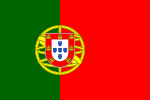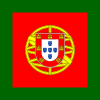
Portuguese Navy
The Portuguese Navy (Portuguese: Marinha Portuguesa, also known as Marinha de Guerra Portuguesa or as Armada Portuguesa) is the naval branch of the Portuguese Armed Forces which, in cooperation and integrated with the other branches of the Portuguese military, is charged with the military defense of Portugal.
Portuguese Navy
1317
- Personnel:
8,200 military
620 paramilitary - Equipment:
5 frigates
2 corvettes
2 submarines
19 patrol vessels
4 research vessels
4 sail ships
43 auxiliary vessels
5 helicopters
Navy Central Facilities, Lisbon
- Ships motto:
Honrai a Pátria que a Pátria vos contempla
(English: "Honor the Fatherland for the Fatherland beholds you") - Heraldic motto:
Talant de bien faire
(English: "Wiling to do well") - Battle cry:
São Jorge
(English: "Saint George")
- Creation of the Portuguese Royal Navy by King Dinis:
12 December 1317 - Discovery of the sea route to India by Vasco da Gama:
20 May 1498
Tracing its origins back to the 12th century, it is the oldest continuously serving navy in the world. On 12 December 2017, the Portuguese Navy commemorated the 700th anniversary of its official creation by King Dinis of Portugal.
The Navy played a key role at the beginning and during the great voyages of the Age of Discoveries in the 15th and 16th centuries. The result of this technical and scientific discoveries led Portugal to develop advanced ships, including the caravel, new and more sophisticated types of carracks for interoceanic travel and the oceanic galleon,[1][2] and to find the sea route to the East and routes to South America and Northern North America.
Bartolomeu Dias rounded the southern tip of Africa and Vasco da Gama reached India, linking Europe and Asia for the first time by ocean route, as well as the Atlantic and the Indian oceans. This led to the discovery of Brazil in the first expeditions that linked Europe, Africa, the New World, and Asia on a single voyage, such as the expedition of Pedro Álvares Cabral, and through the skills and experience of their navigators in the Atlantic, the Indian ocean, and in the Far East, also contributed to the technical and geographical advance of other European navies, such as the first circumnavigation by Ferdinand Magellan (including, in the expedition, other captains, sailors and pilots), sailing across the Atlantic and the Pacific Ocean.
From the late 15th century until the late 16th century, the Portuguese navy had become the most powerful maritime force in the world. For the most of the 16th century, the Portuguese India Armadas and fleets, then the world leader of shipbuilding and naval artillery and technology,[3][4][5] dominated most of the Atlantic Ocean south of the Canary Islands, the Indian Ocean and the access to the western Pacific.[1]
Following the Iberian Union, the Portuguese Empire and its maritime power lost a great deal of its prestige, beginning to decline as other newly emerging European colonial powers began to overtake it.
Today, the Portuguese Navy assumes a dual role capacity: Naval combat missions to assure Portugal's sovereignty and international commitments, and coast guard operations in its territorial waters and areas of influence. The Portuguese Navy also participates in missions related with international commitments assumed by Portugal (mainly within NATO), as well as missions of civil interest.
The Portuguese Navy is under the command of the Chief of Staff of the Navy (CEMA, Chefe do Estado-Maior da Armada). He/she is the only full admiral in active service in the navy and is proposed by the government and vested by the President of Portugal. The CEMA also continues to be the head of the National Maritime Authority, although this became separated from the Navy in 2014.
Besides the CEMA and under his command, the Portuguese Navy includes:
Culture[edit]
Ceremonial musical support[edit]
Musical support is rendered by two formations under the Cultural Center of the Navy: one military band and one fanfare band/drum and bugle corps.

